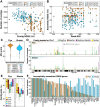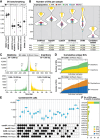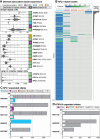High-coverage nanopore sequencing of samples from the 1000 Genomes Project to build a comprehensive catalog of human genetic variation
- PMID: 39358015
- PMCID: PMC11610458
- DOI: 10.1101/gr.279273.124
High-coverage nanopore sequencing of samples from the 1000 Genomes Project to build a comprehensive catalog of human genetic variation
Abstract
Fewer than half of individuals with a suspected Mendelian or monogenic condition receive a precise molecular diagnosis after comprehensive clinical genetic testing. Improvements in data quality and costs have heightened interest in using long-read sequencing (LRS) to streamline clinical genomic testing, but the absence of control data sets for variant filtering and prioritization has made tertiary analysis of LRS data challenging. To address this, the 1000 Genomes Project (1KGP) Oxford Nanopore Technologies Sequencing Consortium aims to generate LRS data from at least 800 of the 1KGP samples. Our goal is to use LRS to identify a broader spectrum of variation so we may improve our understanding of normal patterns of human variation. Here, we present data from analysis of the first 100 samples, representing all 5 superpopulations and 19 subpopulations. These samples, sequenced to an average depth of coverage of 37× and sequence read N50 of 54 kbp, have high concordance with previous studies for identifying single nucleotide and indel variants outside of homopolymer regions. Using multiple structural variant (SV) callers, we identify an average of 24,543 high-confidence SVs per genome, including shared and private SVs likely to disrupt gene function as well as pathogenic expansions within disease-associated repeats that were not detected using short reads. Evaluation of methylation signatures revealed expected patterns at known imprinted loci, samples with skewed X-inactivation patterns, and novel differentially methylated regions. All raw sequencing data, processed data, and summary statistics are publicly available, providing a valuable resource for the clinical genetics community to discover pathogenic SVs.
© 2024 Gustafson et al.; Published by Cold Spring Harbor Laboratory Press.
Figures





Update of
-
Nanopore sequencing of 1000 Genomes Project samples to build a comprehensive catalog of human genetic variation.medRxiv [Preprint]. 2024 Mar 7:2024.03.05.24303792. doi: 10.1101/2024.03.05.24303792. medRxiv. 2024. Update in: Genome Res. 2024 Nov 20;34(11):2061-2073. doi: 10.1101/gr.279273.124. PMID: 38496498 Free PMC article. Updated. Preprint.
References
-
- Akçimen F, Ross JP, Bourassa CV, Liao C, Rochefort D, Gama MTD, Dicaire M-J, Barsottini OG, Brais B, Pedroso JL, et al. 2019. Investigation of the RFC1 repeat expansion in a Canadian and a Brazilian ataxia cohort: identification of novel conformations. Front Genet 10: 1219. 10.3389/fgene.2019.01219 - DOI - PMC - PubMed
-
- AlAbdi L, Shamseldin HE, Khouj E, Helaby R, Aljamal B, Alqahtani M, Almulhim A, Hamid H, Hashem MO, Abdulwahab F, et al. 2023. Beyond the exome: utility of long-read whole genome sequencing in exome-negative autosomal recessive diseases. Genome Med 15: 114. 10.1186/s13073-023-01270-8 - DOI - PMC - PubMed
-
- Alonso I, Jardim LB, Artigalas O, Saraiva-Pereira ML, Matsuura T, Ashizawa T, Sequeiros J, Silveira I. 2006. Reduced penetrance of intermediate size alleles in spinocerebellar ataxia type 10. Neurology 66: 1602–1604. 10.1212/01.wnl.0000216266.30177.bb - DOI - PubMed
MeSH terms
Grants and funding
- U24 HG010263/HG/NHGRI NIH HHS/United States
- R00 HG012796/HG/NHGRI NIH HHS/United States
- R01 HG013017/HG/NHGRI NIH HHS/United States
- U01 AG058589/AG/NIA NIH HHS/United States
- R21 AI174130/AI/NIAID NIH HHS/United States
- U01 HG011744/HG/NHGRI NIH HHS/United States
- DP5 OD033357/OD/NIH HHS/United States
- UG3 NS132105/NS/NINDS NIH HHS/United States
- U24 HG011746/HG/NHGRI NIH HHS/United States
- R03 CA272952/CA/NCI NIH HHS/United States
- T32 HG000035/HG/NHGRI NIH HHS/United States
- R01 HG010169/HG/NHGRI NIH HHS/United States
- U01 CA253481/CA/NCI NIH HHS/United States
- U01 HG011745/HG/NHGRI NIH HHS/United States
- R35 GM142773/GM/NIGMS NIH HHS/United States
- R50 CA243890/CA/NCI NIH HHS/United States
- U01 HG011762/HG/NHGRI NIH HHS/United States
- T32 HG000044/HG/NHGRI NIH HHS/United States
- U01 HG011755/HG/NHGRI NIH HHS/United States
- P30 CA045508/CA/NCI NIH HHS/United States
- U01 HG011758/HG/NHGRI NIH HHS/United States
- U01 DA057530/DA/NIDA NIH HHS/United States
LinkOut - more resources
Full Text Sources
